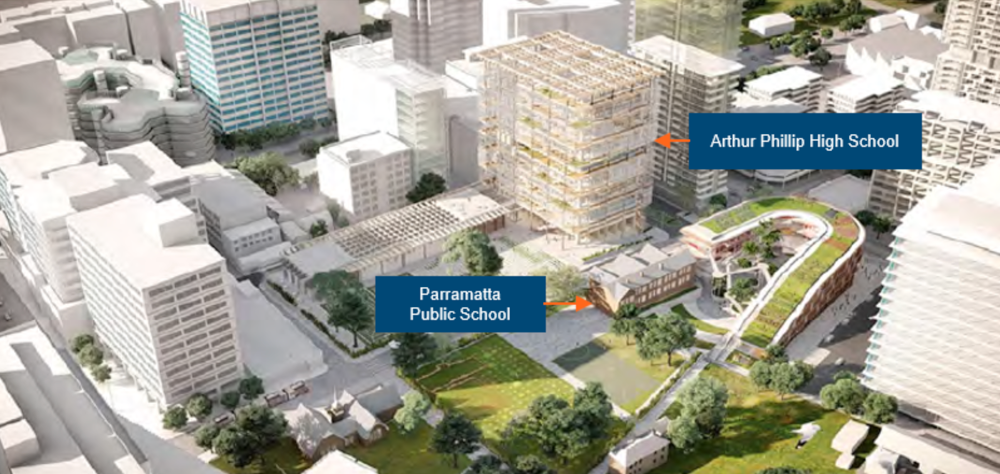APRIL 10 — Following the Education Ministry (MOE)’s endorsement of Kuala Lumpur City Hall (DBKL)’s proposal to construct high-rise schools of up to 17 storeys to address school shortages in densely populated urban areas — commonly called vertical schools — the initiative triggered a public backlash. Much of the criticism appears to stem from great concerns over student safety, as the building’s height and potential overcrowding could lead to significant risks, especially during emergency evacuations.
The concept of vertical schools is not particularly new to Malaysia. According to news reports, the Federal Territory Education Department (JPWPKL) had previously approved and implemented high-rise school buildings, with the tallest being the 10-storey Sekolah Menengah Kebangsaan Seri Sentosa (SMK Seri Sentosa) in Kuala Lumpur. Additionally, the government had recognised the presence and necessity of vertical or high-rise schools, especially in high-density areas, as reflected in the Guidelines and Regulations for Building Planning.
Nonetheless, the decision had significant consequences for the school community. Since its inception, parents and teachers have raised concerns, particularly regarding frequent lift breakdowns. This has resulted in various problems, including students missing recess and both students and teachers being forced to climb up and down all 10 floors to get to classes.
In response to the public backlash, the MOE announced on March 20 that it would launch a pilot project for multi-storey schools in selected states, namely Pulau Pinang, KL, and Putrajaya, this year. Ideally, this pilot project serves as a strategy to test and demonstrate the feasibility and safety of vertical schools, particularly for students and teachers.
While this initiative appears to be a positive first step, greater public awareness and continuous stakeholder engagement are still necessary to ensure that both benefits and risks of building more vertical schools are fully understood and addressed during the planning process.
First things first: What is a vertical school?
Vertical schools were first built in the 21st century in response to urbanisation and land scarcity. They can be defined in various ways — a building with six or more storeys that is typically higher than a horizontal school, which is wider and lower to the ground. Additionally, some of the common physical characteristics of vertical schools highlighted in the literature are that such schools include atriums, balconies, rooftop gardens, terraces, and ‘Hellerup stairs .’
While vertical schools often have limited space on school grounds, the idea is that they are built in central urban areas, connected with nearby outdoor parks or green spaces. This layout provides students with easy access to wider outdoor environments within walking distance.
However, much of the existing evidence draws from case studies and experiences in Australia, where the vertical model has been more widely adopted and studied.
Since the 1990s, Australia has been transitioning away from the traditional horizontal school layout, driven by growing urban communities that necessitate urban consolidation planning policies and urban renewal. Consequently, a significantly larger urban population led to an escalating demand for school spaces among households with school-aged children, especially in Sydney and Melbourne, but it also came with land availability issues. As such, vertical schools are purposed to accommodate teaching, administration, and recreational activities within one or two buildings. For instance, Victoria’s first 10-storey vertical school that was built in 2017 was prompted by the publication of the 2011 census data, which revealed a notable population growth within Melbourne city due to an influx of people migrating from overseas.
In Australia, vertical schools can be divided into two categories – mid-rise (ranging from four to seven storeys) and high-rise (up to seventeen storeys). Mid-rise vertical schools are more common, but in some cases, high-rise vertical schools are considered. For example, the 17-storey Arthur Phillip High School (APHS) in Sydney (Figure 1), which commenced in 2016, was expected to accommodate 3,000 students from different years. Given the substantial number of students to house within the same school, the architectural design took into account several considerations. This included open spaces for social interactions across levels (e.g., extensive balconies and rooftop gardens), fire evacuation, and a “school-within-a-school” model with multi-year communities of 330 students accommodated in a double-storey “home bases” connected to outdoor learning and recreation terraces. Moreover, the design also enables students to be connected to the surrounding community (e.g., Parramatta Public School), with convenient access to public transportation and local landmarks such as Parramatta Railway Station, the Parramatta River, a civic urban space, and the Central Business District (CBD).
Arthur Phillip High School with surrounding community and infrastructure. — From A. Swinburn (2017)
While case studies in Australia provide valuable insights into the functioning of vertical schools, further research within the Southeast Asian context — potentially more relevant to Malaysia — is still limited. Therefore, this highlights the need for more local or regional studies to better inform future planning and implementation.
Potential benefits of vertical schools
1. Optimising limited land space and reducing wastage
Research has shown that the vertical model — typically a single building of at least five storeys on an urban site — requires 50 per cent less land compared to traditional horizontal building. This reduced footprint not only optimises land use but also minimises spatial coverage. Vertical schools are designed for various efficiencies, including better connections to the adjacent community. In Australia, for instance, existing studies showed that most are strategically located near community libraries, parks, and sports and recreational facilities such as swimming pools, providing students with easy access to additional learning and sports amenities. Nonetheless, Malaysia might present a different context, making it crucial to understand the surrounding neighbourhood in the vertical school planning process.
2. Creating interconnected school communities
While the vertical layout may raise worries among staff and students about the challenge of climbing multiple flights of stairs, it can also form a stronger and more interconnected community due to its compact footprint. A key design feature that supports this is the incorporation of atriums or plaza areas, which serve as central gathering spaces that strengthen bonds between students as well as staff. Depending on the structure and design, thoughtfully placed stairs — such as those integrated into atriums or connecting different wings of the school — can act as natural meeting points, facilitating casual social interactions as teachers and students move between classes or floors. In contrast, a traditional linear or horizontal layout would limit these opportunities, making the vertical model suitable for fostering a more dynamic and engaged school environment.
3. Fostering a child-friendly environment
For younger students, such as those still in primary, the design of vertical schools can introduce a sense of connectivity and visual transparency by creating direct links between floors. This fosters a stronger sense of belonging to the schools, enabling them to better adapt to their environment, which is crucial for their overall well-being. To facilitate their needs, the overall layout should prioritise accessibility by minimising stair usage or emphasising adult supervision, which can also pose a challenge due to staff shortage, a common issue in Malaysian public schools. A study in Australia highlighted that movement across multiple flights of stairs was exhausting for younger children (Years 3-5), while it was perceived positively among the older cohorts in Years 6 and 7.
Consideration of risks of vertical schools
More importantly, as the MOE is currently studying the feasibility and plans to launch a pilot project for vertical schools, several key factors, including building standards, quality, and regular maintenance, must be carefully considered to ensure these schools are functional, safe, and efficient. These considerations are especially critical for primary schools, as vertical schools have traditionally been implemented at the secondary level. Moreover, this initiative should be closely aligned with the planned review of existing school construction guidelines announced in 2023. Key areas for consideration should include:
1. Overcrowding at staircases
One of the primary concerns in vertical schools is the risk of congestion at staircases, particularly during peak times such as class transitions, recess, and dismissal. Without proper planning, overcrowding can lead to safety risks and discomfort for students and staff. For instance, if recess is limited to only 20 minutes for all year levels, students on higher floors may face difficulties moving between floors—particularly when elevators are unavailable or out of service — potentially leading them to forgo going down to the canteen altogether. As such, key stakeholders, particularly school leaders, teachers and architects, must explore strategies such as staggered schedules, wider staircases, or additional vertical circulation options like strategically placed elevators to ensure accessibility.
2. Limited entrance and exit points
Certain vertical schools operate with limited main entrances, restricting children’s movement, especially during peak hours. This issue becomes more critical when multiple classes transition simultaneously or in emergency situations where swift evacuation is necessary. To address this, schools should incorporate multiple access points and efficient circulation routes to distribute student movement more evenly across different areas.
3. Supervision challenges
Managing student movement, especially at the primary level, across multiple floors presents a unique challenge for adult supervision, particularly in schools with staff shortages. The regulation of students using different entrances, exits, staircases, and shared spaces requires careful planning to ensure safety and discipline. Schools may need to invest in additional monitoring systems, such as closed-circuit television (CCTV) cameras, designated supervision zones, or structured movement protocols to mitigate these risks.
4. Financial implications
Many existing case studies on vertical schools are based on private institutions, which typically have access to more funding sources. Implementing similar models in public schools may require significant financial investment, especially to cover operational costs related to infrastructure maintenance, safety measures, and adequate staffing. Hence, policymakers must consider sustainable funding options, including government support, public-private partnerships, and innovative cost-efficient designs, to make vertical schools a viable solution for communities.
Concluding thoughts
Schools are not only essential for providing children with access to education but also play a crucial role in forming strongly-bonded communities and optimising limited land use — aspects that can be enhanced through purposeful and innovative architecture, such as vertical schools. While the building guidelines have outlined school design requirements, there is an urgent need for continuous stakeholder engagement to ensure schools operate safely and effectively.
At the same time, the issue of insufficient schools, particularly public schools where most students are enrolled, must be addressed. If not, many school-aged children will potentially be at risk of falling through the cracks, especially students from underprivileged backgrounds who lack the means to attend non-public schools like private education or those whose parents face limited options due to proximity. Therefore, this growing demand for schooling in urban areas calls for alternative solutions like vertical schools. However, these must be implemented with careful consideration of the possible risks, as failure to do so could negatively impact those who regularly use school facilities — especially teachers and students.
* Sofea Azahar is a public policy researcher from the Khazanah Research Institute
** This is the personal opinion of the writer or publication and does not necessarily represent the views of Malay Mail.





